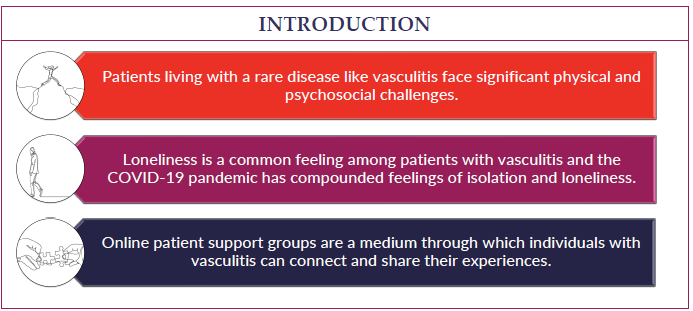Vasculitis Types
About Microscopic Polyangiitis
Last Updated on February 5, 2024
Microscopic polyangiitis (MPA) is a form of vasculitis—a family of rare disorders characterized by inflammation of the blood vessels, which can restrict blood flow and damage vital organs and tissues. MPA most commonly affects the small- to medium-sized blood vessels, particularly involving the kidneys, lungs, nerves, skin, and joints. MPA can worsen rapidly, so early diagnosis and treatment are essential to prevent kidney or respiratory damage, or organ failure.

Quick Facts

Number of cases worldwide unknown

1.5 US cases per 100,000

Any age, but the average onset age is 50

Rare in children

More common in males

Most common in Caucasians
Microscopic polyangiitis (MPA) is a form of vasculitis—a family of rare disorders characterized by inflammation of the blood vessels, which can restrict blood flow and damage vital organs and tissues. MPA most commonly affects the small- to medium-sized blood vessels, particularly involving the kidneys, lungs, nerves, skin, and joints. MPA can worsen rapidly, so early diagnosis and treatment are essential to prevent kidney or respiratory damage, or organ failure.
MPA is part of a group of autoimmune diseases called anti-neutrophil cytoplasmic antibody (ANCA)-associated vasculitis. ANCA refers to a blood protein (antibody) that attacks the body’s own cells and tissues. People with this type of vasculitis often test positive for ANCA, although the test is not conclusive on its own.
MPA is a serious but treatable disease. The traditional course of treatment includes glucocorticoids such as prednisone used in combination with other medications that suppress the immune system and reduce inflammation. Even with treatment, MPA is a chronic condition with periods of relapse and remission, so ongoing medical care and monitoring are necessary.
The cause of MPA is not yet fully understood. Vasculitis is classified as an autoimmune disorder—a disease that occurs when the body’s natural defense system mistakenly attacks healthy tissue. Researchers believe an infection may set the inflammatory process in motion in MPA. Environmental and genetic factors may also play a role.
MPA can affect people of all ages, but the average age of onset is approximately 50. It affects both men and women, but men may get MPA more often. The disease is more frequent among Caucasians but can affect people of any race or ethnic background.
MPA is rare, with an annual incidence of about 1.5 cases per 100,000 people in the United States.
The symptoms of MPA and their severity can vary greatly from person to person, depending on which blood vessels and organs are affected. For some the disease is mild, while for others it may be severe or even potentially life-threatening if untreated. MPA symptoms may come on slowly over a period of months or develop rapidly in a matter of days.
People with MPA often feel generally ill, with flu-like symptoms of fatigue, fever, loss of appetite and weight loss. Other symptoms may be related to the organ systems affected:
- Kidney inflammation, which may be associated with bloody or dark urine. (Note: A patient can have kidney disease without having symptoms; therefore, patients with vasculitis should have regular urine tests.)
- Skin rashes/lesions, especially on the legs
- Cough (coughing up blood, shortness of breath)
- Nerve problems (tingling, numbness, pain, weakness, “foot drop” or “wrist drop,” which is the inability to lift your foot or wrist)
- Joint and muscle pain
- Abdominal pain with eating
- Eye irritation
Serious and even life-threatening complications can occur with MPA, especially affecting the kidneys and lungs. The disease can also cause permanent nerve damage from severe neuropathy. If you have symptoms that don’t go away, have bloody or dark urine, or are coughing up blood, contact your doctor right away.
Because there is no single test for diagnosing MPA, your doctor will consider several factors, including a detailed medical history, physical exam findings, and results of laboratory tests and imaging studies. A biopsy of the affected tissue is usually obtained to confirm the diagnosis.
- Blood tests: The ANCA test can be helpful when positive. Blood tests that can detect inflammation include the erythrocyte sedimentation rate (ESR) test, commonly called the “sed rate,” and the C-reactive protein (CRP) test. All these tests may support a diagnosis of MPA but are not conclusive on their own.
- Urinalysis: The presence of red blood cells may indicate inflammation of the kidneys. Your doctor may use this test to help diagnose MPA, and to monitor the kidneys during and after treatment.
- Tissue biopsy: This surgical procedure removes a small tissue sample from an affected organ, which is examined under a microscope for signs of inflammation or tissue damage. Tissues that might be biopsied for MPA include kidney, lung, skin, nerve, and muscle.
- Imaging studies: Chest X-rays may reveal changes in your lungs that are characteristic of MPA. Computed tomography (CT) and magnetic resonance imaging (MRI) scans provide more detailed images of your internal organs.
The course of treatment for MPA depends on the organs affected and disease severity. Patients with milder disease are commonly prescribed glucocorticoids such as prednisone, in combination with another medication such as methotrexate, to control inflammation and induce remission of disease.
Patients with severe disease may be prescribed the biologic drug rituximab, used in conjunction with glucocorticoids. Rituximab was approved in 2011 by the U.S. Food and Drug Administration (FDA) for the treatment of MPA and another form of vasculitis, granulomatosis with polyangiitis (GPA). Biologic medications are complex proteins derived from living organisms. Biologics target certain parts of the immune system to control inflammation.
Another option for those with severe disease is cyclophosphamide—a chemotherapy-type drug that blocks abnormal growth of certain cells in the body. It is used in combination with glucocorticoids. Cyclophosphamide is usually limited to a three- to six-month period, then replaced with less toxic drugs such as methotrexate, mycophenolate mofetil, or azathioprine.
Once the disease is in remission, patients will need to continue taking maintenance medications such as azathioprine, methotrexate or rituximab, to keep the disease under control. The dose of glucocorticoids is usually tapered during remission.
Some individuals may experience kidney failure, a serious complication that requires dialysis and/or a kidney transplant. A less frequently applied option for those with very serious disease affecting the kidneys or lungs is “plasmapheresis.” Plasmapheresis is a dialysis-like procedure that clears proteins from the plasma of the blood and replaces it with plasma from a donor or a plasma substitute.
In 2021, the medication avacopan (Tavneos ®) was approved by the FDA as an adjunctive treatment in adults for severe active ANCA-associated vasculitis (specifically MPA and GPA) in combination with standard therapy including glucocorticoids. Avacopan (Tavneos®) may help to reduce exposure to glucocorticoids.
Learn more about Tavneos® at Tavneos® Connect
In 2021 the American College of Rheumatology (ACR) published guidelines for the management of certain vasculitides, that were also endorsed by the Vasculitis Foundation (VF). Clinical practice guidelines are developed to reduce inappropriate care, minimize geographic variations in practice patterns, and enable effective use of health care resources. Guidelines and recommendations developed and/or endorsed by the ACR are intended to provide guidance for particular patterns of practice and not to dictate the care of a particular patient. The application of these guidelines should be made by the physician in light of each patient’s individual circumstances. Guidelines and recommendations are subject to periodic revision as warranted by the evolution of medical knowledge, technology, and practice.
The medications used to treat MPA have potentially serious side effects, such as lowering your body’s ability to fight infection, and potential bone loss (osteoporosis), among others. Therefore, it’s important to see your doctor for regular checkups. Medications may be prescribed to offset side effects. Infection prevention is also very important. Talk to your doctor about getting vaccines (e.g., flu shot, pneumonia and/or shingles vaccination), which can reduce your risk of infection.
Even with effective treatment, MPA is a chronic disease, and relapses of the disease may occur. If your initial symptoms return or you develop new ones, report them to your doctor as soon as possible. Regular doctor visits and ongoing monitoring of laboratory and imaging tests are important in detecting relapses early.
Effective treatment of MPA may require the coordinated efforts and ongoing care of a team of medical providers and specialists. In addition to a primary care provider, MPA patients may need to see the following specialists:
- Rheumatologist (joints, muscles, immune system)
- Pulmonologist (lungs)
- Nephrologist (kidneys)
- Dermatologist (skin)
- Neurologist (brain/nervous system) or other medical professionals as needed
The best way to manage your disease is to actively partner with your health care providers. Get to know the members of your health care team. It may be helpful to keep a health care journal to track medications, symptoms, test results and notes from doctor appointments in one place. To get the most out of your doctor visits, make a list of questions beforehand and bring along a supportive friend or family member to provide a second set of ears and take notes.
Remember, it’s up to you to be your own advocate. If you have concerns about your treatment plan, speak up. Your doctor may be able to adjust your dosage or offer different treatment options. It is always your right to seek a second opinion.
Living with a chronic disease such as MPA can be challenging at times. Fatigue, pain, emotional stress, and medication side effects can take a toll on your sense of well-being, affecting relationships, work, and other aspects of your daily life. Sharing your experience with family and friends, connecting with others through a support group, or talking with a mental health professional can help.
There is no known cure for MPA at this time, but with early diagnosis and proper treatment, many patients can lead full, productive lives. Because relapses may occur with MPA, follow-up medical care is essential.
Learn more about ANCA-Associated Vasculitis (AAV) https://www.anca101.com/
Microscopic Polyangiitis Videos
Current Treatments for GPA and MPA including Avacopan
ACR_VF Guidelines: GPA-MPA Breakout
Research Insights: Improving Diagnostics and Treatment of Small-Vessel Vasculitis
MPA Patient Hero: Kathy Olevsky































































